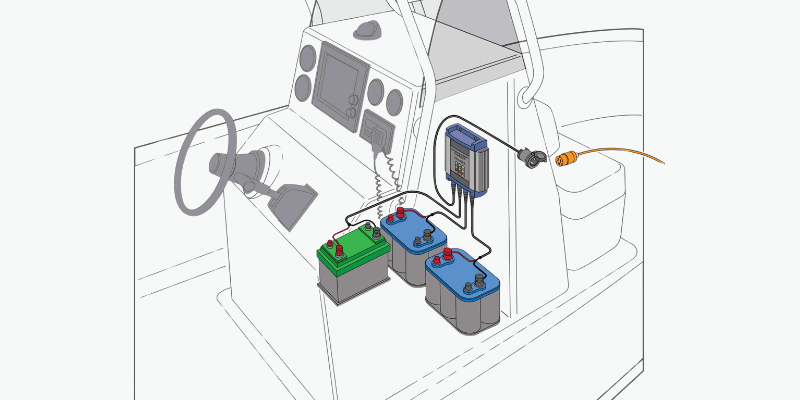Nabíjanie námornej batérie je nevyhnutné pre bezstarostný zážitok z plavby. Táto príručka obsahuje typy nabíjačiek lodných batérií, ich aplikácie a kompatibilitu s vašou batériou. Odporúčame prečítať si naše blog o základoch námornej batérie pred preskúmaním nabíjania.
Aké sú typy námorných nabíjačiek batérií?
Existujú dva typy lodných nabíjačiek: palubné a prenosné. Vodáci si vyberajú na základe svojich zvykov, pričom niektorí si vyberajú oboje ako zálohu alebo kvôli flexibilite. Výber závisí od faktorov, ako je typ plavby, frekvencia používania a rozpočet.
Palubné nabíjačky námorných batérií
Palubné námorné nabíjačky sú trvalo nainštalované a pripojené k elektrickému systému lode. Automaticky monitorujú stav batérie a upravujú rýchlosť nabíjania. Tieto nabíjačky sú ideálne pre tých, ktorí používajú svoje lode v blízkosti pobrežných zdrojov energie alebo prístavov, čím sa eliminuje potreba prenosnej nabíjačky.
Medzi spôsoby palubného nabíjania patria:
- Pobrežné nabíjanie: Táto bežná metóda sa používa, keď je vaša loď zakotvená v prístave, pričom využíva nabíjačku námorných batérií pripojenú k externému zdroju energie.
- Nabíjanie na mori: Táto metóda na rozdiel od pobrežného nabíjania využíva na nabíjanie batérií palubné generátory alebo alternatívne zdroje energie. Integrácia solárnych systémov zvyšuje udržateľnosť a sebestačnosť, čo je životne dôležité pre cesty na dlhé vzdialenosti.
- Nabíjanie alternátora: Keď ste na vode, alternátor motora nabíja batérie vytváraním elektrickej energie. Primárne však udržiava nabitie štartovacej batérie a nemusí sa úplne nabiť a batéria s hlbokým cyklom alebo efektívne zaobchádzať s hlboko vybitými batériami.

Prenosné námorné nabíjačky batérií
Prenosné námorné nabíjačky sú kompaktné a všestranné na nabíjanie batérií na palube aj na súši. Prichádzajú v manuálnych, automatických a inteligentných modeloch s rôznymi typmi batérií.
Tieto nabíjačky sú ideálne pre plavbu loďou, keď je potrebná flexibilita, a umožňujú dobíjanie mimo pobrežných zdrojov alebo prístavov. Pre majiteľov viacerých lodí alebo požičovní je vhodná jedna adaptabilná nabíjačka. Vodáci, ktorí dbajú na rozpočet, ich uprednostňujú aj pre ich nákladovú efektívnosť v porovnaní s palubnými systémami.
Kompatibilita nabíjačky
Vaša nabíjačka musí byť kompatibilná s vašou batériou, či už zabudovanou alebo prenosnou.
V prípade jednej batérie skontrolujte jej napätie (zvyčajne označené, napr. 12 voltov pre námorné batérie) a uistite sa, že sa vaša nabíjačka zhoduje. Zvážte kapacitu v ampérhodinách (Ah); výkon nabíjačky by mal byť 10-20% tejto kapacity. Napríklad 100Ah batéria potrebuje nabíjačku s výstupom 10-20 ampérov.
Pridanie ďalšej batérie komplikuje nabíjanie podľa toho, ako sú zapojené: sériovo alebo paralelne. V sérii sa napätia pridávajú; dve 12-voltové batérie vytvárajú 24 voltov, čo si vyžaduje 24-voltovú nabíjačku. Paralelne zostáva napätie konštantné, ale kapacita sa zdvojnásobí; dve 12-voltové batérie poskytujú dvojnásobnú kapacitu pri zachovaní 12 voltov. Použite nabíjačku, ktorá zvládne kombinované potreby prúdu – ak máte paralelne dve 100Ah batérie, vyberte si takú, ktorá dokáže efektívne nabíjať až 200Ah. Môžete získať viac informácií o zapojení batérií do série a paralelne tu.

Aký je význam viacstupňového nabíjania?
Inteligentné nabíjačky sú vhodné pre námorné použitie vďaka svojej technológii a nutnosti udržiavať zdravé batérie. Prenosné aj palubné verzie ponúkajú inteligentné možnosti nabíjania, ktoré optimalizujú efektívne a bezpečné nabíjanie batérie.
Na rozdiel od tradičných nabíjačiek využívajú inteligentné nabíjačky viacstupňový prístup – bulk,absorpcia a float urýchľujú nabíjanie a zároveň zabezpečujú životnosť batérie. Táto metóda zabraňuje prebíjaniu postupným znižovaním prúdu, keď sa batéria blíži k plnej kapacite.
V náročnom námornom prostredí, kde je spoľahlivé napájanie dôležité pre navigáciu a elektroniku, inteligentné nabíjačky zvyšujú bezpečnosť a predlžujú životnosť batérie, čo z nich robí cennú investíciu pre majiteľov lodí.
Deep Cycle AGM VS Lithium
Nabíjanie námorných batérií AGM s hlbokým cyklom sa líši od nabíjania lítiových batérií kvôli ich chemickému zloženiu. Olovené batérie s hlbokým cyklom vyžadujú viacstupňový proces – objem, absorpcia a plávanie pre optimálny výkon; nesprávne nabíjanie môže výrazne znížiť životnosť.
Naproti tomu lítiové námorné batérie sú vybavené riadiacimi systémami, ktoré zabraňujú prebíjaniu a prehrievaniu. Zvládnu vyššie rýchlosti nabíjania a vybíjania a ponúkajú rýchlejšie nabíjanie ako tradičné batérie s hlbokým cyklom.

Tipy na nabíjanie
Keď identifikujete nabíjačku, ktorú potrebujete, postupujte podľa týchto osvedčených postupov pre námorné nabíjanie:
Vyhnite sa prebíjaniu: Používajte inteligentné nabíjačky, ktoré monitorujú stav batérie a upravujú nabíjanie tak, aby nedošlo k poškodeniu.
Udržiavajte plné nabitie: Batérie udržujte plne nabité, aby ste predišli sulfatácii, najmä v olovených batériách. Lítiové batérie sú menej ovplyvnené čiastočným nabitím.
Pravidelná údržba: Skontrolujte úrovne nabitia, úrovne elektrolytu (pri zaplavených batériách) a pripojenia svoriek. Vyčistite skorodované koncovky a uistite sa, že sú tesné.
Správne skladovanie: Keď sa nepoužíva, použite prípravok na údržbu batérie alebo nabíjačku. Batérie skladujte na chladnom a suchom mieste.
Postupujte podľa pokynov výrobcu: Dodržiavajte pokyny špecifické pre váš typ batérie.
Vyberte si medzi palubnými alebo prenosnými námornými nabíjačkami na základe vašich zvykov pri plavbe. Palubné nabíjačky ponúkajú pohodlie, zatiaľ čo prenosné nabíjačky poskytujú všestrannosť. Zabezpečte kompatibilitu prispôsobením napätia, kapacity a funkcií vašej batérie.
Dodržiavaním týchto pokynov si zachováte spoľahlivý zdroj energie pre vaše dobrodružstvá na lodi.

